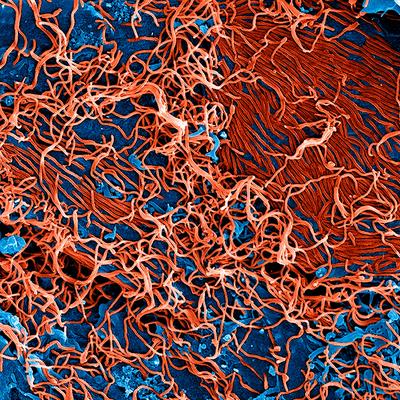slobodan paessler
University of Texas Medical Branch at Galveston
Galveston, United States
2,199
Total views and downloads
Submission closed
The Filoviridae (Filoviruses) are a family of viruses that cause some of the most severe and deadly viral diseases in humans and non-human primates.
The virus family includes several human pathogens, with the most well-known members being the Ebola virus (EBOV) and Marburg virus (MARV). These viruses are responsible for diseases such as Ebola virus disease (EVD) and Marburg virus disease (MVD), which can cause systemic infection associated with severe hemorrhagic fever and high mortality rates.
Below is some general background information on filoviruses, their pathogenesis, impact on human health, and current methods of prevention and treatment:
1. Pathogenesis:
· Entry and Replication: Filoviruses enter the human body through contact with infected animals or their bodily fluids. Once inside the body, they infect immune cells, such as macrophages and dendritic cells. The virus then replicates rapidly, leading to a high viral load in the bloodstream and systemic dissemination that results in productive infection of many organs.
· Immune Evasion: Filoviruses are known for evading the host immune system. They can suppress the host’s innate and adaptive immune responses, leading to uncontrolled viral replication and high virus load in many organs.
· Disruption of Blood Clotting: One hallmark of filovirus infections is the disruption of the blood clotting system, leading to hemorrhagic symptoms. The virus can damage blood vessel walls, impair platelet function reduce platelet counts, and cause disseminated intravascular coagulation (DIC).
2. Impact on Human Health:
· Severe Symptoms: Filovirus infections can result in a wide range of symptoms, including high fever, severe headache, muscle pain, weakness, vomiting, diarrhea, and in severe cases, hemorrhagic manifestations such as bleeding from the nose, gums, and other sites. Neurological complications have been reported too.
· High Mortality: The Ebola virus has been associated with high mortality rates, with some outbreaks recording case fatality rates as high as 90%. Marburg virus infections also have a significant mortality rate, albeit somewhat lower.
· Outbreaks: Filovirus outbreaks tend to occur sporadically in central and western Africa. These outbreaks can strain local healthcare systems and have the potential to spread to other regions.
3. Prevention:
· Vaccines: Several experimental vaccines have been developed for Ebola virus, and some have shown promising results. The rVSV-ZEBOV-GP vaccine, for example, was used in a ring vaccination strategy during the West African Ebola outbreak and demonstrated effectiveness. Most recently, ERVEBO® (Ebola Zaire Vaccine) was approved by the U.S. Food and Drug Administration (FDA) for the prevention of disease caused by Ebola virus (EBOV; species Zaire ebolavirus) in individuals 12 months of age and older.
· Infection Control: Preventing the spread of filoviruses within healthcare settings is crucial. This involves strict infection control measures, including the use of personal protective equipment (PPE) and isolation of infected individuals.
· Public Health Measures: Surveillance, contact tracing, and quarantine measures are essential to contain outbreaks and prevent further transmission.
4. Treatment:
· Therapies: Two of the antiviral therapeutic products, Inmazeb™ and Ebanga™, have deployed in ebolavirus outbreaks and were approved by the FDA in 2020, becoming the first approved therapeutics against a filovirus.
· Supportive Care: There is no specific antiviral treatment for filovirus infections. Supportive care, including rehydration, pain management, and treatment of specific symptoms, is the primary approach.
Filoviruses remain a significant public health concern due to their potential to cause devastating outbreaks with high mortality rates. Ongoing research is focused on developing effective multivalent vaccines, broad antiviral treatments, and improved strategies for outbreak control and prevention.
This special topic in the Virology section of Frontiers in Microbiology invites authors to contribute original research, reviews, and perspectives that shed light on the complexities of filoviruses, with a particular focus on Ebola and Marburg viruses. Manuscripts focusing on Ebola virus pathogenesis, host responses, evasion mechanisms, epidemiology, vaccines, and structural and replication studies are encouraged. This call for papers aims to promote a comprehensive understanding of filoviruses, particularly the Ebola virus, and to identify potential therapeutic interventions.
Topics include but are not limited to:
• Viral evasion and non-immune defense mechanisms, as well as host recognition and recognition signaling specific to both viruses.
• Novel regulatory pathways and therapeutic interventions targeting the virus.
• Vaccine development and evaluation.
• Structural and replication studies to elucidate virus biology.
• Epidemiological and ecological studies for a better understanding of virus transmission dynamics.
• Pathology and infection sequelae, with a particular focus on survivors’ health outcomes following virus infection.
We welcome submissions that provide insights into the Ebola and Marburg virus and other filoviruses, aiming to advance knowledge on their pathogenesis and impact on human health. Join us in the collective effort to combat filovirus infections and contribute to the development of effective strategies for prevention and treatment.

Keywords: Filoviridae, Ebola Virus
Important note: All contributions to this Research Topic must be within the scope of the section and journal to which they are submitted, as defined in their mission statements. Frontiers reserves the right to guide an out-of-scope manuscript to a more suitable section or journal at any stage of peer review.
Share on WeChat
Scan with WeChat to share this article
